Irene Yoo on Nunchi and the Art of Korean BBQ
"The rules for eating Korean BBQ are to eat quickly and eat a lot."
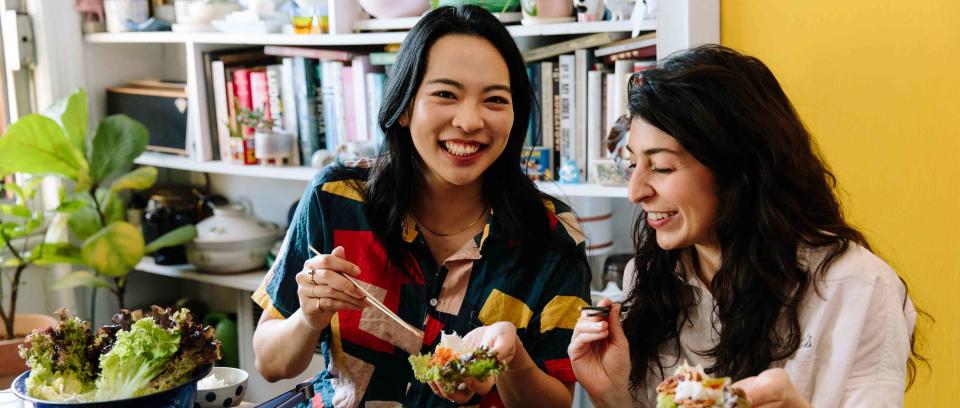
Simply Recipes / Christine Han
As a kid sidling up to dinner, there was nothing odd about Umma (my mother) firing up a portable camp stove right on the table, when the kitchen stove was six feet away. Even though she had already washed the lettuce leaves and made the jjigae—Korean for ”stew”—in the kitchen, the main part of the meal had to be cooked where we sat down to eat, because when Koreans barbecue, the eating and grilling happens at the same time. The barbecued meat must get to our plates seconds after being cooked.
Then an unspoken dance would begin. Umma ladened our table with all the standard Korean BBQ trimmings: a mound of freshly washed red leaf lettuce, dollops of brick-red ssamjang, piles of her kimchi, and a still-bubbling pot of homey doenjang jjigae. Thinly sliced beef brisket shingles, still frozen, sat next to the portable stove. Meanwhile, Appa (my dad) would shake the butane can, finagle the canister into the stove, and fire it up to heat the pan atop.
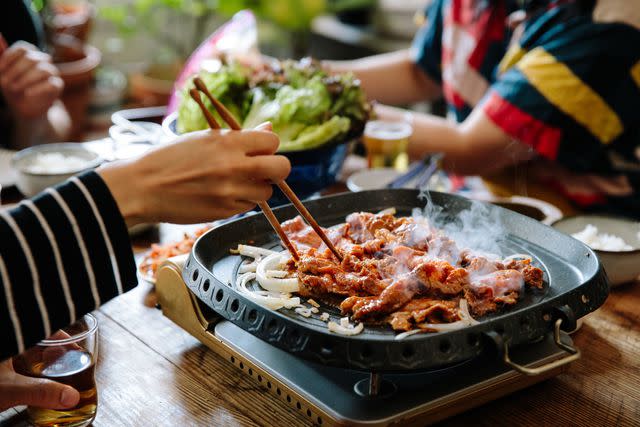
Simply Recipes / Christine Han
The meat would defrost in mere minutes, just enough so that he could separate a few slices off and toss them onto the hot pan. He flipped them every few seconds, and I watched the thin squares curl at the edges, sizzle, and crisp up.
Appa hurriedly scooped the meat up with wooden chopsticks—only wooden when cooking and metal chopsticks for eating—and piled them onto our plates. “Ppalli muk-uh!” He urged us to eat quickly. Breaking with tradition, it was the only time we wouldn’t wait for my father, the eldest, to take the first bite. Eating while hot was tantamount.
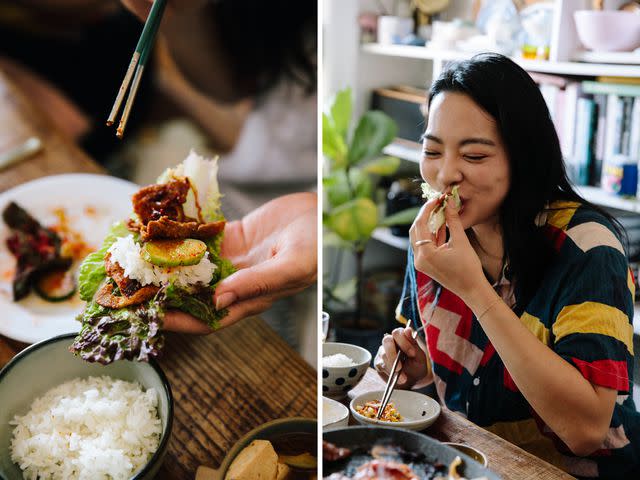
Simply Recipes / Christine Han
I grabbed a piece of lettuce, shook off the water droplets still clinging to the frilly edges, snuggled in a few pieces of brisket, topped it with ssamjang, and popped the ssam—the bundle—into my mouth in one go. Once a package of frozen meat was opened and defrosted, there was no use putting it back in the freezer—it had to all go into our bellies. The rules for eating Korean BBQ are to eat quickly and eat a lot.
I don’t even remember the first time we ate like this—perfectly choreographed movements that felt like something we had always known and done. As a child of Korean immigrants growing up in America, so much of our culture, including how we ate, was communicated in this unspoken way. Did I always know how to hold my chopsticks? Since when did I know if the kimchi was too fermented, or not fermented enough?
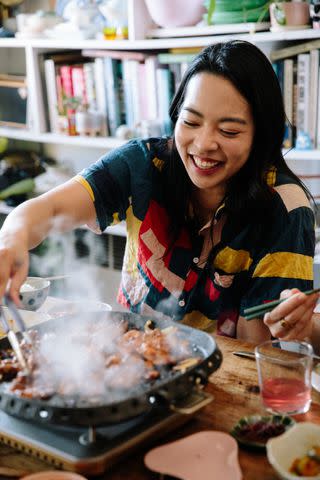
Simply Recipes / Christine Han
This portable camp stove popped up on our table regularly. It didn’t even call for a special occasion—if anything, it appeared when my mom was least interested in cooking. She pulled out a package of frozen meat that she stocked up on when it was on sale at the Asian grocery store—thinly sliced beef brisket, thicker cards of pork belly, and marinated beef or spicy pork bulgogi. The rest of the prep was simple: wash some lettuce, put out the banchan, scoop bowls of rice. It was a reliable and easy dinner option that she could reach for at any time.
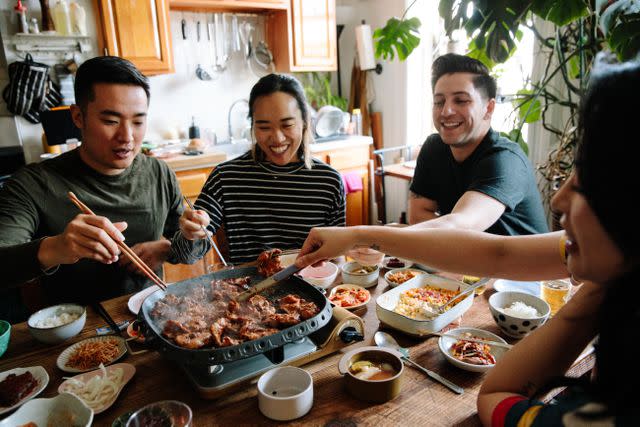
Simply Recipes / Christine Han
During these meals I learned nunchi, the Korean art of assessing the needs of those around me—speed-reading the situation and reacting, a silent awareness. Nunchi for when the meat needs to be flipped and for when someone’s plate is almost empty of meat, all while carrying on with the business of feeding myself.
I watched Umma, amazed, as she folded a huge ssam in such a way that she could tuck the whole thing into her mouth in one go. I followed along, folding the leaves into the corners of my cheeks. Appa was skilled at making sure our plates always had meat, topping them if reserves got low or brusquely chiding us if we weren’t eating quickly enough.
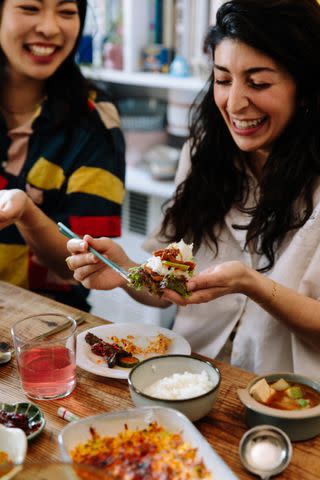
Simply Recipes / Christine Han
This learned awareness carried across many dinner tables. It’s how I learned how to eat like a Korean—watching how my uncle stacked his spoon with different banchan pairings, or how my grandmother poured a bit of cold barley tea into the dregs of rice to scoop up every last kernel. It’s also how I learned to eat non-Korean food: by watching friends or strangers eat. The nunchi then grew into a desire to feed others, sensing when a friend needed to be fed, or wanted someone to eat with.
I hosted my first Korean BBQ during Hurricane Irene, my namesake. I was stuck in my railroad Brooklyn apartment—the subways and local businesses shut down out of caution. With nowhere to go and nothing else to do, I invited friends over for a dinner party.
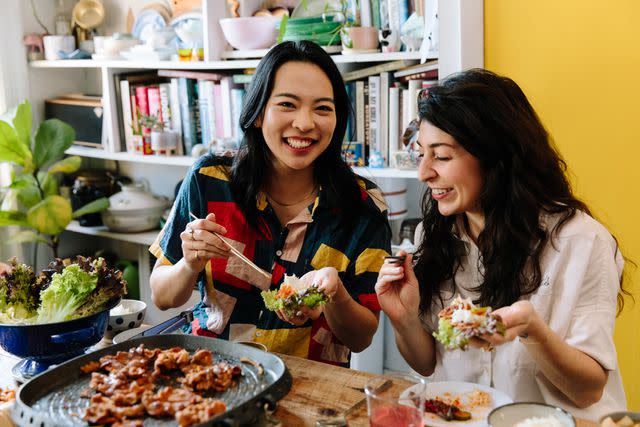
Simply Recipes / Christine Han
I pulled out my own portable camp stove and a couple of butane cans I had bought. I dragged over the corner coffee table to the middle of the living room and my friends and I gathered around the tiny appliance. I mined from the deep well of my mom’s home-cooked meals and scrounged for veggies in my fridge to make doenjang jjigae. I reached for the emergency pork belly in my freezer—the stash I had unknowingly created, just like my mom did.
Mimicking Appa, I threw the meat onto the pan as quickly as I could while my friends swooped in with chopsticks, grabbing still-sizzling pieces of meat while dodging grease splatters. They stayed late into the night, pouring each other beer, sharing stories, and finding more things to throw onto the pan when we ran out of meat, like rice and instant ramyun.
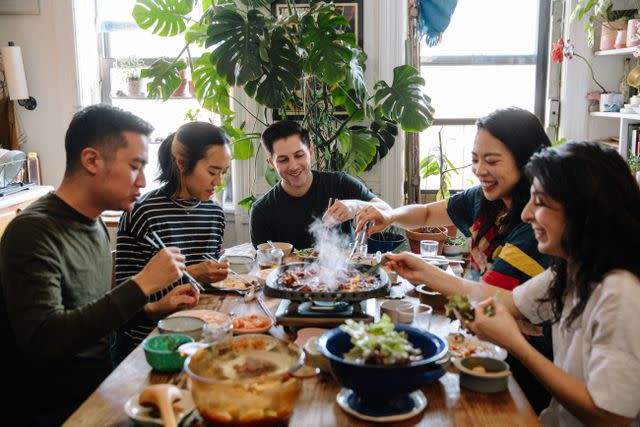
Simply Recipes / Christine Han
Though I made sure my friends were well fed, they too silently sensed each other’s need for more food, more drink, and more connection. Korean BBQ with my friends, like it’s always been with my family—became a place where nunchi and the art of feeding each other represent the unspoken love we have for each other.

